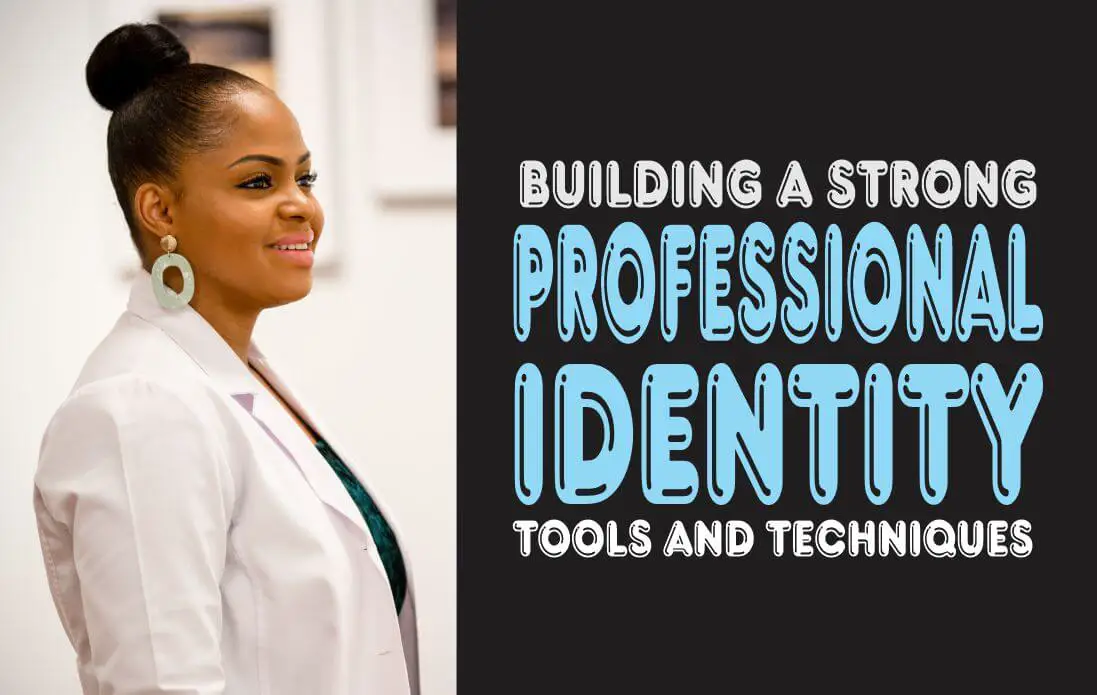Last updated on March 9th, 2025 at 11:17 am
Discover how to build a strong and authentic professional identity. Learn tips and tricks to showcase your skills and stand out in a competitive job market.
In today’s competitive job market, it is crucial to craft a both personal identity and a professional personality to stand out and increase your chances of success.
This involves assessing your skills, setting personal and professional goals, and developing a unique brand that aligns with your values.
A step-by-step guide is available to help you through this process, from defining your personal brand to building a strong online presence.
It offers practical tips and tools to differentiate yourself and achieve career success, whether you’re a recent graduate or an experienced professional.
This guide ensures your professional identity makes a lasting impression. See an introductory guide on identity.
Suggested: How to Overcome Identity Diffusion
Table of Contents
- What is Professional Identity?
- Professional Identity Formation
- Assessing Your Skills and Strengths
- Building a Personal Brand
- Online Presence and Networking
- Developing Thought Leadership
- Continuous Learning and Skill Development to Build Professional Identity
- Building a Professional Image
- Leveraging Feedback and Evaluation
- Conclusion
What is Professional Identity?
Professional identity is an essential concept, which refers to how an individual perceives themselves in their profession, what they are proud of, and how they communicate their professional persona to the world.
It is the image, reputation, and perception that professionals have of themselves in their respective fields.
Professional identity comprises four significant components as outlined below:
Skills and knowledge: The skills and knowledge professionals possess in their field play a crucial role in shaping their professional individuality.
Experiences: The experiences professionals have had in their field, including education, training, and work experience, can help shape their professional distinctiveness.
Values and attitudes: The values and attitudes professionals hold and practice in their profession help define who they are as professionals.
Identity supports: The individuals and groups that encourage and support the professional persona of an individual, such as colleagues, mentors, and family members.
Related: Crafting Your Identity: Self-Discovery And Personality Development
Why Professional Identity Matters in Today’s Competitive Job Market
Considering the current job market’s competitiveness, it is crucial to establish a strong professional identity.
Professional identity can help professionals set themselves apart from their competitors by highlighting their unique skills, experiences, and accomplishments.
It can also help increase their chances of gaining employment and promotion by creating a positive image of themselves.
Moreover, it also involves networking and building relationships with colleagues, clients, and industry peers.
Building strong professional relationships can help open up new job opportunities and collaborations.
Benefits of a Strong Professional Identity for Career Growth
A strong professional personality can bring numerous benefits to professional growth, such as the following:
Increased recognition in the industry: It can help professionals become recognized and respected in their field, leading to new job opportunities, awards, and promotions.
Greater job satisfaction: It can help professionals achieve greater job satisfaction, which can lead to improved performance and productivity in the workplace.
Building a personal brand: A strong professional identity can help professionals establish a personal brand, leading to increased credibility and visibility in the industry.
Career advancement: It can also open up new job opportunities and help create a career path for advancement and growth in the industry.
Related: What is Social Identity?

Professional Identity Formation
Professional identity formation is a process that begins with self-reflection and continues throughout your career.
It involves developing a clear understanding of your skills, values, and goals, and then communicating that understanding to others.
This process can be broken down into several key steps:
- Self-reflection: The first step in professional identity formation is to reflect on your skills, values, and goals. What are your strengths and weaknesses? What motivates you? What are your long-term career goals?
- Skill development: Once you have a clear understanding of your skills, you can begin to develop them further. This may involve taking courses, attending workshops, or seeking out mentorship opportunities.
- Networking: Building a strong professional network is essential for professional identity formation. This involves connecting with others in your field, attending industry events, and seeking out mentorship opportunities.
- Branding: Once you have developed your skills and built your network, it’s time to start building your personal brand. This involves creating a consistent image across all of your professional channels, including your resume, social media profiles, and personal website.
In the next section, we are going to delve deeper into the formation of professional identity and everything surrounding it.
Assessing Your Skills and Strengths
In the journey towards professional growth and success, it is crucial to have a clear understanding of your skills and strengths.
By assessing and identifying these key attributes, you can leverage them effectively to advance your career.
In this section of this article, we will explore three powerful strategies to assess your skills and strengths: self-reflection, conducting a SWOT analysis, and utilizing assessment tools towards professional identity formation.
1. Self-reflection and Identification of Key Skills
Self-reflection is the starting point for understanding your skills and strengths.
Take time to introspect and delve into your past experiences, both personal and professional.
What tasks do you excel at?
What activities bring you joy and a sense of fulfillment?
Consider feedback received from colleagues, supervisors, or clients.
Identify recurring themes and areas where you consistently demonstrate proficiency.
These are the clues that reveal your key skills and strengths.
2. Conducting a SWOT Analysis to Evaluate Strengths and Areas for Improvement
A SWOT (Strengths, Weaknesses, Opportunities, Threats) analysis is a powerful tool to assess your skills comprehensively.
- Strengths: attributes and skills that give you an advantage over others.
- Weaknesses: areas in which you need to improve to achieve your goals.
- Opportunities: Opportunities presented by external factors that you can leverage for your benefit.
- Threats: external factors that could hinder your progress.
Start by listing your strengths, the skills and attributes that give you a competitive edge.
Next, identify your weaknesses or areas where improvement is needed. Be honest and objective in your assessment.
Then, explore opportunities that align with your strengths and can further enhance your skills.
Finally, consider potential threats or challenges that may hinder your progress.
This analysis will provide valuable insights into areas where you excel and areas that require development.
Related: The Role Of Personality In Career Choices
3. Leveraging Tools like Self-assessment Tests or Personality Assessments
Beyond self-reflection and SWOT analysis, there are various assessment tools available to gain a deeper understanding of your skills and strengths.
Self-assessment tests, such as career assessments or skill inventories, can provide structured assessments of your abilities and interests.
These tests often generate reports that highlight your strengths and suggest suitable career paths.
Additionally, personality assessments like the Myers-Briggs Type Indicator (MBTI) or DISC assessment can shed light on your natural tendencies and how they relate to your work preferences and strengths.
These tools offer valuable insights and validate your self-assessment findings.

Building a Personal Brand
Building a personal brand is more than just creating a polished image. It’s about embracing your authentic self and expressing your unique value to the world.
By defining your unique value proposition, crafting a compelling personal brand statement, and creating consistency across various platforms, you can cultivate a powerful personal brand that sets you apart.
Your brand will attract opportunities, build trust, and leave a lasting impact on those you encounter.
Remember, your personal brand is an ongoing journey of self-discovery and growth.
Here are ways to achieve that:
1. Defining Your Unique Value Proposition
To build a strong personal brand, start by identifying your unique value proposition.
Ask yourself: What sets you apart from others?
What skills, experiences, or perspectives make you valuable?
Understand your strengths, passions, and the distinct value you bring to the table.
Consider the challenges you excel at solving or the needs you fulfill.
By defining your unique value proposition, you can position yourself as an indispensable resource in your field.
2. Crafting a Compelling Personal Brand Statement
A personal brand statement is the core essence of your brand. It’s a concise, powerful message that communicates who you are and what you offer.
Craft a statement that reflects your expertise, values, and the impact you aim to make. Keep it authentic, engaging, and memorable.
Consider your target audience and how you want them to perceive you. Your personal brand statement should inspire and resonate with others, leaving a lasting impression.
3. Creating Consistency Across Various Online and Offline Platforms
Consistency is key when it comes to building a personal brand. Ensure that your brand is cohesive across all platforms, both online and offline.
Start by auditing your online presence.
Update your LinkedIn profile, ensuring it reflects your personal brand statement and showcases your accomplishments.
Develop a professional website or portfolio that aligns with your brand identity.
Leverage social media platforms strategically, sharing valuable content that reinforces your expertise.
In offline interactions, maintain consistency in your messaging, appearance, and networking efforts.
By creating a consistent brand experience, you reinforce your credibility and build trust with your audience.
Online Presence and Networking
Your online presence and networking efforts can be catalysts for your professional growth and success.
By optimizing your LinkedIn profile, creating a professional website, engaging in online communities, and building a strong network, you establish a solid foundation in the digital space.
Embrace the power of the digital age to expand your reach, connect with industry peers, and unlock new possibilities.
Remember, genuine engagement, authenticity, and consistent efforts are the keys to nurturing a thriving online presence and a robust professional network.
Leverage these digital tools to propel your career forward and seize the opportunities that await you.
Here are ways to achieve that:
1. Optimizing LinkedIn Profile for Professional Branding
LinkedIn is a powerful platform for professional networking and branding. Optimize your profile to make a memorable first impression.
Craft a compelling headline that highlights your expertise and unique value proposition.
Write a captivating summary that showcases your accomplishments and aspirations. Add relevant skills, education, and certifications.
Share engaging content that demonstrates your industry knowledge and thought leadership.
Build connections with professionals in your field and engage in meaningful conversations.
A well-optimized LinkedIn profile can position you as a reputable professional and attract opportunities your way.
Related: What Are The Big Five Scientific Personality Traits?
2. Creating a Professional Website or Portfolio
A professional website or portfolio is a digital hub that showcases your work, achievements, and personal brand.
Create a visually appealing and user-friendly website that reflects your professional identity.
Include a bio that captures your story and expertise. Showcase your best work samples, projects, and testimonials.
Share insights through a blog or resource section. Ensure your website aligns with your personal brand and is easily discoverable through search engines.
A professional website or portfolio serves as a powerful tool to showcase your skills and expertise to potential employers, clients, and collaborators.
3. Engaging in Relevant Online Communities and Forums
Active engagement in online communities and forums can expand your network and expose you to new opportunities.
Join industry-specific groups and forums where professionals gather to discuss trends, share insights, and ask questions.
Contribute meaningfully by sharing your expertise, offering valuable advice, and participating in discussions.
Establish yourself as a helpful and knowledgeable resource within these communities.
This engagement not only strengthens your professional reputation but also opens doors to collaborations, mentorship, and job prospects.
4. Building and Nurturing a Professional Network
Networking is a cornerstone of career success, and the digital landscape offers abundant opportunities to build and nurture a professional network.
Attend virtual industry events, webinars, and conferences to connect with like-minded professionals.
Follow influential thought leaders in your field and engage with their content.
Reach out to professionals you admire and initiate conversations. Be genuine, supportive, and proactive in maintaining connections.
Don’t forget to reciprocate and offer assistance or proffer solutions when you can.
A strong professional network can provide guidance, support, and access to hidden opportunities throughout your career journey.
Related: Personality And How It is Developed: Types, Theories, And Tests
Developing Thought Leadership
Developing thought leadership is a transformative journey that allows you to make a significant impact in your field.
By establishing yourself as an expert, sharing knowledge through blogging and content creation, contributing to industry publications, and participating in webinars or workshops, you unlock your influence and inspire others.
Embrace the power of your expertise, share your unique insights generously, and engage with your audience authentically.
Thought leadership is not just about recognition; it’s about making a lasting impact and driving positive change.
Start your journey today and become a respected thought leader in your industry, leaving a legacy of knowledge and inspiration for others to follow.
Here are ways to achieve that:
1. Establishing Yourself as an Expert in Your Field
Thought leadership begins with positioning yourself as a knowledgeable authority in your field.
Cultivate deep knowledge and expertise through continuous learning, staying up-to-date with industry trends, and seeking out opportunities for professional development.
Share your expertise generously by offering insights, advice, and solutions to common challenges.
Engage in conversations, both online and offline, and showcase your thoughtfulness and expertise through active participation in industry-specific discussions.
By consistently demonstrating your knowledge and providing value, you establish yourself as a trusted authority.
2. Sharing Knowledge through Blogging or Content Creation
Blogging or creating valuable content is a powerful way to showcase your expertise and share knowledge with a wider audience.
Start a blog or contribute articles to industry publications. Share practical tips, insights, and thought-provoking perspectives through well-crafted content.
Use storytelling techniques to make your ideas relatable and engaging. Regularly publish high-quality content that demonstrates your expertise and addresses the needs and interests of your target audience.
Share your content through various channels, including social media, email newsletters, and professional networks, to expand your reach and influence.
3. Contributing to Industry Publications or Speaking at Conferences
To further establish your thought leadership, contribute your insights and expertise to industry publications.
Seek opportunities to write guest articles, op-eds, or research papers for respected publications in your field.
This allows you to reach a broader audience and gain visibility as a thought leader.
Additionally, consider speaking at conferences, seminars, or panel discussions relevant to your industry.
Sharing your expertise in front of an audience positions you as an authority and provides opportunities for networking and collaboration.
4. Participating in Webinars or Hosting Workshops
Webinars and workshops are excellent platforms for thought leaders to share knowledge, engage with their audience, and build a strong personal brand.
Participate as a guest speaker in webinars hosted by industry organizations or create your own webinars to address specific topics of interest.
Offer practical insights, case studies, and actionable strategies to help participants overcome challenges.
Similarly, consider hosting workshops or training sessions where you can delve deeper into your expertise and provide hands-on guidance to attendees.
These interactive sessions create opportunities to establish your thought leadership while fostering meaningful connections with your audience.
Continuous Learning and Skill Development to Build Professional Identity
Continuous learning and skill development are the pillars of a strong professional brand.
By actively identifying industry trends, pursuing relevant certifications or further education, seeking out mentorship and professional development opportunities, and attending conferences and workshops, you can cultivate a dynamic skill set and stay ahead in a competitive landscape.
Embrace a growth mindset, invest in your learning journey, and embrace the opportunities that come with expanding your expertise.
Remember, building a resilient professional identity is an ongoing process that requires dedication, curiosity, and a commitment to lifelong learning.
Empower yourself with knowledge, skills, and a hunger for growth, and watch your professional identity flourish.
1. Identifying Industry Trends and Staying Updated
To build a solid professional brand, it’s crucial to stay abreast of industry trends.
Actively seek out relevant resources such as industry publications, blogs, podcasts, and social media channels.
Engage in conversations and networking events with professionals in your field.
Join online communities and forums where industry discussions take place.
By staying updated on emerging technologies, market shifts, and best practices, you can adapt quickly and position yourself as a knowledgeable expert.
2. Pursuing Relevant Certifications or Further Education
Continuous learning often involves pursuing relevant certifications or further education to expand your skill set.
Identify key areas of growth or skills that align with your career goals.
Research and select certifications or courses that provide comprehensive knowledge and practical application in those areas.
Online platforms, universities, and professional organizations offer a wealth of opportunities for structured learning.
By obtaining certifications or pursuing higher education, you demonstrate a commitment to professional growth and enhance your credibility in the field.
3. Seeking Out Mentorship and Professional Development Opportunities
Mentorship and professional development opportunities can greatly accelerate your skill development and professional identity.
Seek out mentors within your industry who can provide guidance, support, and valuable insights based on their experiences.
Actively participate in professional development programs, workshops, or seminars offered by industry associations or your employer.
Engage in cross-functional projects or initiatives to broaden your skill set. Embrace feedback and constructive criticism to continuously refine your abilities.
By actively seeking mentorship and professional development opportunities, you gain access to invaluable guidance and foster a growth mindset.
4. Attending Conferences and Workshops to Enhance Skills
Conferences and workshops offer immersive learning experiences and opportunities for skill enhancement.
Look for industry-specific events that align with your interests and professional goals.
Attend presentations, panel discussions, and workshops delivered by industry experts.
Connect and interact with professionals who share similar interests and engage in valuable discussions.
Take advantage of hands-on activities or breakout sessions to develop practical skills.
Conferences and workshops not only enhance your knowledge but also expand your network and provide inspiration for innovation and growth.
Building a Professional Image
Building a professional image is a multifaceted endeavour that requires attention to various aspects of your personal and interpersonal presence.
By dressing and grooming for success, practicing effective communication skills, developing strong interpersonal skills and emotional intelligence, and demonstrating professionalism in all interactions, you can create a lasting impression that opens doors to opportunities and advancement.
Remember, building a professional image is an ongoing process that requires self-awareness, continuous improvement, and a commitment to excellence.
Embrace these principles, align them with your personal values, and watch your professional image shine brightly, leaving a lasting impact on those around you.
Below are ways to go about it:
1. Dressing and Grooming for Success
Your appearance plays a significant role in shaping your professional image.
Dressing appropriately and grooming well sends a powerful message about your attention to detail and professionalism.
Understand the dress code expectations in your industry and company.
Dress in a manner that reflects your role and the level of formality in your workplace.
Pay attention to hygiene, grooming, and personal presentation.
Dressing and grooming for success not only boost your confidence but also commands respect and enhances your credibility.
2. Practicing Effective Communication
Effective communication is a cornerstone of professional success.
Cultivate strong communication skills to articulate your thoughts clearly, listen actively, and adapt your communication style to different audiences.
Develop your verbal and written communication abilities, paying attention to grammar, tone, and professionalism.
Practice active listening, asking thoughtful questions, and providing concise and meaningful responses.
Effective communication encourages understanding, builds relationships, and positions you as a reliable and trustworthy professional.
3. Developing Strong Interpersonal Skills and Emotional Intelligence
Interpersonal skills and emotional literacy are vital components of a strong professional image.
Build rapport, show empathy, and demonstrate respect when interacting with colleagues, clients, and superiors.
Develop your ability to collaborate, negotiate, and resolve conflicts in a constructive manner.
Enhance your emotional intelligence by understanding and managing your own emotions and recognizing and empathizing with the emotions of others.
Strong interpersonal skills and emotional intelligence contribute to a positive and harmonious work environment while strengthening your professional relationships.
4. Demonstrating Professionalism in All Interactions
Demonstrating professionalism in all interactions sets the foundation for a strong professional image.
Maintain a positive attitude, integrity, and ethical behavior. Be punctual, reliable, and accountable for your actions and commitments.
Respect confidentiality and handle sensitive information with discretion.
Display a strong work ethic and strive for excellence in your work. Show appreciation for the contributions of others and support a collaborative and inclusive work culture.
By consistently demonstrating professionalism, you establish yourself as a trusted and respected professional.
Leveraging Feedback and Evaluation
Leveraging feedback and evaluation is a transformative process in building a strong professional identity.
By actively seeking feedback from mentors, peers, and supervisors, evaluating and adjusting your professional identity based on that feedback, and cultivating a growth mindset, you can refine your strengths, address areas for improvement, and continuously grow as a professional.
Embrace feedback as a gift that provides valuable insights and propel your growth.
Don’t forget that building a professional identity is a long-term project and feedback serves as a compass to guide you towards greater success and fulfillment.
Embrace this process with openness and dedication, and watch your professional identity flourish.
Here are steps to achieve that:
1. Seeking Feedback from Mentors, Peers, and Supervisors
Seeking feedback from trusted individuals in your professional network is a crucial step in building a strong professional identity.
Approach mentors, peers, and supervisors and request constructive feedback on your performance, skills, and areas of improvement.
Create an environment of open communication where feedback is encouraged and valued.
Actively listen to their perspectives and insights, embracing both positive feedback and constructive criticism.
This feedback can provide valuable insights into how others perceive your professional identity and highlight areas where you can refine and grow.
2. Evaluating and Adjusting Your Professional Identity Based on Feedback
Once you receive feedback, take the time to evaluate and reflect on it.
Assess whether the feedback aligns with your own self-perception and goals.
Identify patterns and recurring themes in the feedback to gain a comprehensive understanding of how your professional brand is perceived by others.
Use this evaluation as an opportunity to make adjustments and refinements to your behavior, skills, or approach.
Adapt your professional identity to align with your desired goals while maintaining authenticity.
Understand that the goal is not to change who you are but to enhance your strengths and address areas for growth.
3. Developing a Growth Mindset and Embracing Continuous Improvement
Developing a growth mindset is essential for leveraging feedback and evaluation to build a strong professional identity.
Embrace the belief that your abilities can be developed and improved through effort and dedication.
View feedback as an opportunity for growth rather than a reflection of your shortcomings.
Embrace the mindset of continuous improvement, always seeking ways to refine your skills and expand your knowledge.
Actively pursue professional development opportunities, such as training programs, workshops, or online courses, to enhance your skills and broaden your expertise.
By adopting a growth mindset and committing to continuous improvement, you position yourself for long-term success and personal fulfillment.
Conclusion
Building a strong professional identity requires conscious effort and the use of various tools and techniques.
This article emphasizes the importance of defining your unique value proposition, creating a compelling personal brand statement, maintaining consistency across online and offline platforms, and utilizing tools like LinkedIn, professional websites, and online communities.
It urges readers to take action and use this information as a blueprint for building their professional identity, tailoring it to their specific goals.
Investing in one’s professional identity yields lasting benefits, including credibility, expertise, trust, career growth, and fulfilling work experiences.
The article encourages readers to implement these tools and techniques to achieve success in their careers.
Frequently Asked Questions
1. What is professional identity?
It refers to the way an individual presents themselves in a professional setting, including their skills, knowledge, values, and reputation.
2. Why is building a professional identity important?
Building a professional brand is important because it can help individuals establish credibility, gain recognition, and advance their careers. It can also help individuals differentiate themselves from others in their field and build a strong personal brand.
3. How can I build my professional identity?
There are several ways to build your professional identity, including networking, developing your skills and knowledge, creating a strong online presence, and seeking out opportunities to showcase your expertise.
4. What are some tips for creating a strong online presence?
To create a strong online presence, you should consider creating a professional website or blog, using social media to connect with others in your field, and regularly sharing your work and insights online. It’s also important to maintain a professional tone and avoid sharing anything that could be seen as unprofessional or offensive.
5. How can I showcase my expertise?
You can showcase your expertise by speaking at conferences or events, writing articles or blog posts, participating in online forums or communities, and volunteering for projects or initiatives related to your field. It’s also important to be proactive in seeking out opportunities to share your knowledge and skills with others.
References:
- Five Powerful Benefits of Establishing a Professional Identity
- Development of Professional Identity in Social Work Education
- Develop your professional identity
- Developing professional identity in multi-professional teams
Pyo Merez (PsyD) is a distinguished adolescent and adult psychologist at the forefront of mental health advocacy.
With expertise in cognitive and developmental psychology, focusing on social relationships, cultural contexts, and individual differences, Pyo has dedicated his career to empowering adolescents and adults.
As a sought-after speaker and panelist, Pyo shares invaluable insights on issues affecting young people, contributing to a deeper understanding of mental health and well-being in today's society.


